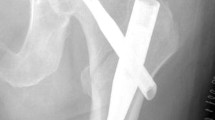Abstract
Introduction
The purpose of this study was to determine if varus displacement of intertrochanteric femur fractures on injury radiographs is associated with screw cutout after fixation.
Methods
A retrospective review performed at two urban level 1 trauma centers identified 334 patients with intertrochanteric femur fractures treated with either a cephalomedullary nail (CMN) or a sliding hip screw (SHS). Median patient age was 75 years, 69% were female and 46% had unstable fractures. Varus fracture displacement on injury radiographs, defined as the most proximal aspect of the femoral head being at or below the most proximal aspect of the greater trochanter, was present in 38% of patients. Screw cutout was recorded.
Results
Varus displacement was associated with unstable fracture patterns (62% vs. 37%, difference (D) 25%, 95% confidence interval (CI) 15–35%), female gender (77% vs. 64%, D 13%, CI 3–22%) and poor/adequate reductions (54% vs. 41%, D 13%, CI 2–23%). Cutout occurred in 9 (3%) patients, 8 of which had varus displacement. There was no detectable difference, with wide confidence intervals, between patients that did and did not experience cutout in terms of age, gender, unstable fractures, implants, tip-apex distance (TAD) or poor/adequate reductions. On univariate and multivariate analysis, varus displacement was the only variable associated with cutout. Patients with and without varus displacement had a cutout incidence of 6 and 0.5% (Odds ratio 13, CI 1.6–108).
Conclusion
Intertrochanteric fractures presenting with varus displacement were more likely to experience cutout. This potential risk factor for cutout warrants further study.
Level of evidence
Level 3, retrospective cohort.


Similar content being viewed by others
References
Murena L, Moretti A, Meo F et al (2018) Predictors of cut-out after cephalomedullary nail fixation of pertrochanteric fractures: a retrospective study of 813 patients. Arch Orthop Trauma Surg 138(3):351–359
Caruso G, Bonomo M, Valpiani G et al (2017) A six year retrospective analysis of cut-out risk predictors in cephalomedullary nailing for pertrochanteric fractures: can the tip-apex distance (TAD) still be considered the best parameter? Bone Jt Res 6(8):481–488
Shannon SF, Yuan BJ, Cross WW et al (2019) Short versus long cephalomedullary nails for pertrochanteric hip fractures: a randomized prospective study. J Orthop Trauma 33(10):480–486
Fujii T, Nakayama S, Hara M et al (2017) Tip-apex distance is most important of six predictors of screw cutout after internal fixation of intertrochanteric fractures in women. JBJS Open Access 2(4):e0022
Baumgaertner MR, Curtin SL, Lindskog DM et al (1995) The value of the tip-apex distance in predicting failure of fixation of peritrochanteric fractures of the hip. J Bone Joint Surg Am 77(7):1058–1064
Ciufo DJ, Zaruta DA, Lipof JS et al (2017) Risk factors associated with cephalomedullary nail cutout in the treatment of trochanteric hip fractures. J Orthop Trauma 31(11):583–588
Parry JA, Sapp T, Langford JR et al (2020) Variables associated with lag screw sliding after single-screw cephalomedullary nail fixation of intertrochanteric fractures. J Orthop Trauma. 34:356–358
Meinberg EG, Agel J, Roberts CS et al (2018) Fracture and dislocation classification compendium-2018. J Orthop Trauma 32(Suppl 1):S1–S170
Parry J, Barrett I, Schoch B et al (2018a) Does the angle of the nail matter for pertrochanteric fracture reduction? matching nail angle and native neck-shaft-angle. J Orthop Trauma 32:174–177
Pajarinen J, Lindahl J, Savolainen V et al (2004) Femoral shaft medialisation and neck-shaft angle in unstable pertrochanteric femoral fractures. Int Orthop 28(6):347–353
Serrano R, Blair JA, Watson DT et al (2017) cephalomedullary nail fixation of intertrochanteric femur fractures. J Orthop Trauma 31(11):577–582
Parry JA, Barrett I, Schoch B et al (2018b) Validation of neck-shaft angle correction after cephalomedullary nail fixation. J Orthop Trauma 32(10):505–507
Jung SW, Shim SB, Kim HM et al (2015) Factors that influence reduction loss in proximal humerus fracture surgery. J Orthop Trauma 29(6):276–282
Solberg BD, Moon CN, Franco DP et al (2009) Locked plating of 3- and 4-part proximal humerus fractures in older patients: the effect of initial fracture pattern on outcome. J Orthop Trauma 23(2):113–119
Garcia P, Holstein JH, Maier S et al (2008) Development of a reliable non-union model in mice. J Surg Res 147(1):84–91
Nilsson LT, Johansson Å, Strömqvist B (1993) Factors predicting healing complications in femoral neck fractures: 138 patients followed for 2 years. Acta Orthop 64(2):175–177
Funding
None.
Author information
Authors and Affiliations
Corresponding author
Ethics declarations
Conflict of interest
Joshua Langford is on the editorial board of the journal of orthopaedic trauma; receives royalties from advanced orthopaedic solutions; has stock options with core orthopaedics; and is a paid consultant for Orthogrid and stryker. Kenneth Koval is a paid speaker or consultant for Biomet and Stryker; and receives publishing royalties from Wolters Kluwer health. George Haidukewych in on the editorial or governing board of the journal of orthopaedic trauma; receives royalties from and is a paid consultant for Biomet, Depuy and Synthes; and has stock or stock options from orthopediatrics. The remaining authors have nothing to disclose. Cyril Mauffrey has the following disclosures: Abbott: Other financial or material support; Carbofix: Research support; current opinion in orthopaedics: Editorial or governing board; DePuy, A Johnson & Johnson Company: Other financial or material support; International Orthopaedics: Editorial or governing board; La Societe Internationale de Chirurgie Orthopedique et de Traumatologie: Board or committee member; Orthopaedic Trauma Association: Board or committee member; osteomed: Research support; Patient safety in surgery: Editorial or governing board; Springer: Publishing royalties, financial or material support; Stryker: Paid consultant; Unpaid consultant; The European journal of orthopaedic surgery and traumatology: Editorial or governing board. Joshua Parry has the following disclosures: The European journal of orthopaedic surgery and traumatology: Editorial or governing board. None of the remaining authors have anything to disclose.
Additional information
Publisher's Note
Springer Nature remains neutral with regard to jurisdictional claims in published maps and institutional affiliations.
Rights and permissions
About this article
Cite this article
Hwang, J., Hadeed, M., Sapp, T. et al. Varus displacement of intertrochanteric femur fractures on injury radiographs is associated with screw cutout. Eur J Orthop Surg Traumatol 31, 683–687 (2021). https://doi.org/10.1007/s00590-020-02820-1
Received:
Accepted:
Published:
Issue Date:
DOI: https://doi.org/10.1007/s00590-020-02820-1




